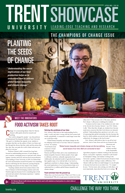Neanderthals and modern humans would have co-existed long enough to allow for significant cultural and genetic exchange, according to a paper co-authored by Trent University anthropology professor Eugène Morin, published in the prestigious journal Nature.
The new data challenges the long-held view that modern humans simply replaced the Neanderthals as they expanded into Western Europe between 41,000 and 39,000 years ago. For the first time, the new paper provides a more refined timeline for the disappearance of Neanderthal populations from Western Europe than any previous research.
The findings by Prof. Morin along with an international group, led by Professor Tom Higham of Oxford University, have important implications for research into the cultural, technological and biological elements involved in the replacement of Neanderthals by modern humans. “One potential implication is that interactions between distinct populations—even those as distinct as Neanderthals and early modern humans—are extremely complex and rarely result in simple and direct replacement of one group by another,” said Prof. Morin.
According to Prof. Morin’s research, as a consequence of extremely unfavourable climatic conditions, Neanderthals experienced severe population decline, yet succeeded in maintaining genetic ties with other neighbouring populations, including the incoming anatomically modern humans from Africa. This process allowed the diffusion of Neanderthal traits into the modern human gene pool. These findings provide support to the hypothesis that Neanderthals contributed, although to a moderate extent, to the emergence of modern humans.
Working on team projects of this kind across the globe provides many opportunities for the exchange of ideas and keeping up to date on the latest advances in the field, Prof. Morin said. “Pulling together all these data from a wide range of sites and regions is always a challenge, but the results are often quite productive. This paper fits nicely with my own research on Neanderthal and early modern human adaptation, and especially, their subsistence strategies.”
The research project was funded by the Natural Environment Research Council (NERC), the Leverhulme Trust, through the Ancient Human Occupation of Britain (AHOB) project, the NRCF (NERC Radiocarbon Facility) programme, Keble College (Oxford), the European Research Council and the Social Sciences and Humanities Research Council (SSHRC) of Canada.
The paper will be published online on Wednesday, August 20, and may be accessed at the following link: http://www.nature.com/nature/journal/v512/n7514/full/nature13621.html
Posted on Thursday, August 21, 2014.


































